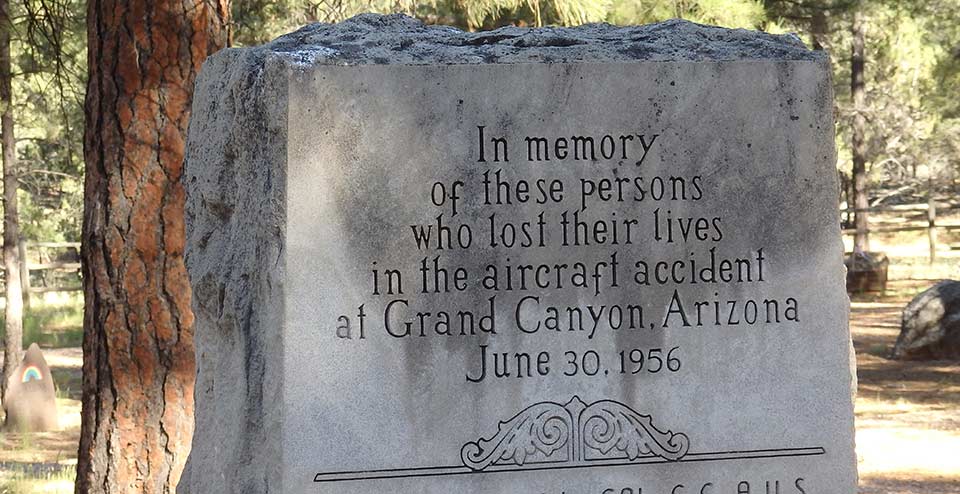All day long the jet contrails cross the sky over the Canyon, southwest to northeast. They drift leeward, fading and breaking up, and soon they are gone. The pilots of the jets making those white streaks each cheerily tell their passengers to look out of the right or left side of the plane to see the magnificent Grand Canyon from 30,000 feet. If you get around, it's probably happened to you.

Sixty years ago this past June 30th, two pilots did the same. It's expected on cross country flights and was even then, yet tragedy awaited those sightseers just minutes away from the suggestion. The midair crash of TWA #2 and United #718, both plummeting into the Canyon with no survivors, is a famous story in aviation. These first few weeks in July were an awful chapter in Grand Canyon history as well, with the country riveted by the incredibly difficult search and recovery efforts.
Each plane left Los Angeles Airport (not yet LAX) at about 10 AM, on a planned crisscross path, after significant delays. They flew around opposite sides of the same Cumulonimbus cloud, at near the same altitude, over the Village and the South Rim of the Canyon at 11:30 AM, and met in the sky over the Temple Butte area north of Desert View Overlook. You can see the site and a Memorial there at Desert View. Both aircraft hit the ground at great speed and disintegrated into balls of fire. Horror, controversy and blame followed quickly behind the event. The terrible result led to the formation of the Federal Aviation Administration. An exhaustive account of the crash, in which all 128 people died, was written recently, "We Are Going In", by Mike Nelson.
In these years after 9/11, we have all become familiar with the consequences of coincidence. What if you missed your flight and had to change it? What if you stopped for coffee on the way to work? What if you didn't? What if, what if what if? Despite both planes being directed near each other, and despite both changing course under accepted authorization, the chance of such an accident was infinitesimal. Yet it happened.
At a Memorial three weeks later, the Pastor of the Grand Canyon Community Church directed everyone's attention to the God-created "unmatched wonder and beauty" all about them. The implication, of course, was that mourners should not forget to embrace the splendor of life along with the sorrow. We can hope that some of those doomed people, the lucky or blessed ones, had a few seconds when they knew the end was imminent and were able to reach out to God with acceptance, beginning their journey even before the door to the afterlife opened.
On the day after 9/11 I perched on a granite outcrop in eastern Long Island Sound and stared to the west, looking for smoke. Too far away, but like all of you, I can see it in my mind still. I drove through Shanksville, PA on the way here and was reminded again of the randomness of life, how we must learn over and over to accept death as a part of life (let's skip the existence of evil for now), and sitting here I agree that if my number comes up, let me see a flash of earth's beauty before the end. The Grand Canyon will do fine.
All day today the jet contrails will cross the sky over the Canyon, southwest to northeast. They'll drift with the wind, and soon they will be gone.
Return to Inspiration Point Blog Index Page
This blog is meant to encourage awareness and thoughtfulness about the Grand Canyon, one of our most precious resources. It is not merely a story of what happens or has happened here, not a cookbook for what you should make of it yourself, but more an example of the many-faceted inspiration the Canyon nurtures in an artist, perhaps in you. Indeed, inspiration may be the Canyon’s greatest resource. These words are sincere, my own take on this world, deliberately non-academic and directed toward users of social media. In no way does it represent the policies or opinions of the National Park Service, although it is done under the auspices of that entity, but is offered in gratitude, with my respect and admiration for these soldiers of conservation. George H. Jacobi 2016
